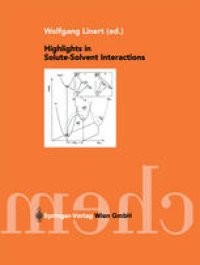
Ebook: Highlights in Solute-Solvent Interactions
- Tags: Analytical Chemistry, Organic Chemistry, Inorganic Chemistry, Characterization and Evaluation of Materials
- Year: 2002
- Publisher: Springer-Verlag Wien
- Edition: 1
- Language: English
- pdf
Most organic molecules retain their integrity when dissolved, and even though in such cases the effects exerted by solvents are, in the language of the coordination chemist, of the "outer sphere" kind, the choice of solvent can be critical to the successful outcome of an operation or preparation. Solubilities of reactants and products must be taken into account, and even if the organic principals in the reactions retain their integrity, many of the reagents are electrolytes, and their state of aggregation will affect their reactivity. In testifying to the importance of understanding solute-solvent interactions I draw attention to a large class of inorganic species for which the involvement in the chemical and physical properties by the solvent is even more deeply seated. It is comprised by the large body of metal atoms in low oxidation states for which solvent molecules intervene as reagents. At the same time, because the ions carry charges, the effects arising from outer sphere interactions are usually greater than they are for neutral molecules. To cite an example: when FeCb(s) is dissolved in water to form a dilute - say O. OlO- solution there is a complete reorganization of the coordination sphere of the cation. Whereas in the solid each cation is surrounded by six chloride ions, in the solution the dominant form is [Fe(H20)6]3+ followed by [Fe(H20)sCI]2+, [Fe(H20)4CI2]+, etc. in rapidly decreasing abundance.
Content:
Front Matter....Pages I-IX
Ionic Solvation in Aqueous and Nonaqueous Solutions....Pages 1-32
Spin Equilibrium in Solutions....Pages 33-41
Invited Review Thermochromism and Solvatochromism in Solution....Pages 43-58
Recent Advances in the Description of the Structure of Water, the Hydrophobic Effect, and the Like-Dissolves-Like Rule....Pages 59-90
Thermodynamic Investigation of Phase Equilibria in Metal Carbonate-Water-Carbon Dioxide Systems....Pages 91-110
The Solvent-Like Nature of Silica Particles in Organic Solvents....Pages 111-125
Prediction of Electrolyte Solubilities from Minimal Thermodynamic Information....Pages 127-150
Preferential Solvation in Mixed Solvents X. Completely Miscible Aqueous Co-Solvent Binary Mixtures at 298.15 K....Pages 151-175
Phase Transitions and Critical Behaviour of Binary Liquid Mixtures....Pages 177-196
Extraction of Unprotected Amino Acids by Mixed-Ligand Nickel(II) and Copper(II) Chelates....Pages 197-202
Solvent Effects on Ion-Pair Distribution and Dimerization of Tetraalkylammonium Salts....Pages 203-214
Back Matter....Pages 215-222
Content:
Front Matter....Pages I-IX
Ionic Solvation in Aqueous and Nonaqueous Solutions....Pages 1-32
Spin Equilibrium in Solutions....Pages 33-41
Invited Review Thermochromism and Solvatochromism in Solution....Pages 43-58
Recent Advances in the Description of the Structure of Water, the Hydrophobic Effect, and the Like-Dissolves-Like Rule....Pages 59-90
Thermodynamic Investigation of Phase Equilibria in Metal Carbonate-Water-Carbon Dioxide Systems....Pages 91-110
The Solvent-Like Nature of Silica Particles in Organic Solvents....Pages 111-125
Prediction of Electrolyte Solubilities from Minimal Thermodynamic Information....Pages 127-150
Preferential Solvation in Mixed Solvents X. Completely Miscible Aqueous Co-Solvent Binary Mixtures at 298.15 K....Pages 151-175
Phase Transitions and Critical Behaviour of Binary Liquid Mixtures....Pages 177-196
Extraction of Unprotected Amino Acids by Mixed-Ligand Nickel(II) and Copper(II) Chelates....Pages 197-202
Solvent Effects on Ion-Pair Distribution and Dimerization of Tetraalkylammonium Salts....Pages 203-214
Back Matter....Pages 215-222
....